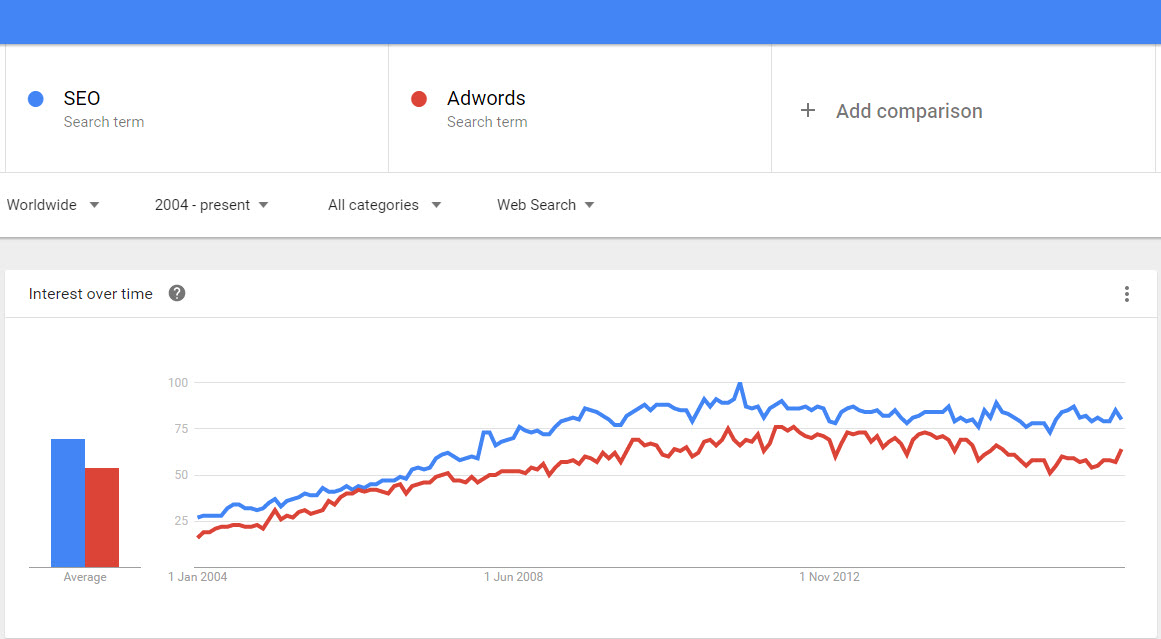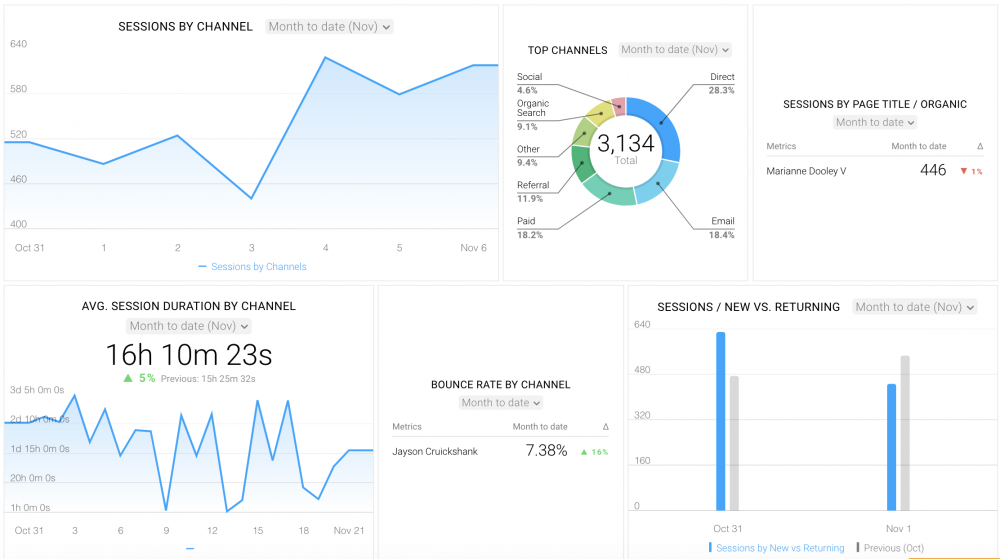
Google Trends is Your Friend: How to Use it to Write Content
Google Trends can be a valuable free tool in content marketing. It can be used in your content marketing strategy to identify topics that resonate with your target audience, as well as to create more effective content. Here are some things to know about Google Trends and how you can implement it in your marketing efforts.

What is Google Trends?
Google Trends is a web-based tool that showcases search trends by users on Google. It is operated by Alphabet Inc., the company that owns Google. You can use the tool to see what people are searching for and when, and see how the search demand for certain keywords has evolved over time. You can also find new keywords that could apply to your own business.
Take Advantage of What People Search For
The most important reason to use Google Trends is to learn what people search for related to your business and to use that information to create carefully targeted content featuring in-demand keywords to drive website traffic. If you currently create content with low search volumes, adding keywords people frequently use could allow your website to rank higher in search results. There is no point investing in content that your target market isn’t searching for.

Use Search and Filters Appropriately
To find the most relevant results, it is important to use search tools and filters appropriately. This can help to remove irrelevant data and ensure that the information you access isn’t skewed with incorrect information. You can also separate SEO trends by category. This can have a significant impact on the information provided by Google Trends.
For instance, if you wanted to search for information about the Tampa Bay Lightning, you actually don’t want to find local weather reports. You want data and suggested related keywords about the professional hockey team. By using the sports category, it will help remove the weather-related results.
Keyword Research
Google’s Keyword Planner is the go-to source for finding keywords for upcoming SEO efforts, but Google Trends can help to reveal different yet valuable keywords you might miss if you only use the Keyword Planner. Since the algorithms used to show suggested keywords are different in both applications, you could end up with many additional keywords you might have otherwise missed.
Forecast Seasonal Peaks
The number of searches for a keyword changes over time. Whereas some keywords, such as “fidget spinner,” are trendy but eventually go out of fashion, other keywords experience annual or seasonal peaks. For example, people are more likely to research fireworks laws around the Fourth of July or New Years than around Thanksgiving time, because of the seasonal demand for fireworks.
Seasonal peaks don’t have to line up with federal holidays or with the actual seasons. There are other reasons a keyword might peak during certain times of the year. Forecasting seasonal peaks can help you to develop more timely content, such as blog posts, before the peak ends this time around.
Develop Reactive Content
If you regularly check out the data on Google Trends as a part of your content marketing strategy, you can quickly develop reactive content based on the topics that are trending—for example, a celebrity dies suddenly, or a competitor comes out with its latest products. You can use this opportunity to write posts about what people are currently talking about.
For instance, new information came out about the possible safety risks from using compostable sugarcane plates at restaurants like Chipotle. It was a huge national story that involved warnings about one of the chemical compounds found in the plates and whether it would leak into the food. If your company produced sugarcane plates, it would be extremely important to develop reactive content that highlighted the safety studies completed on the plates and how the plates were safe for customers to use. The timeliness of identifying this trend would be extremely important.
Sometimes, the lack of a timely response causes more problems than the initial issue. When the documentary about orca captivity Blackfish came out, SeaWorld already knew that the movie existed. It had time to proactively develop an effective strategy to combat the negative press that came with the movie. Yet, the company failed to do anything. SeaWorld leaders assumed that the hype would just fizzle on its own.
However, the movie didn’t fizzle out. It gained momentum and was featured on major media networks and distributed by the video giant Netflix. The company did not make any outward steps to address the search trends related to its core business, assuming the negative press would eventually stop and it could continue business as normal. Instead of going away, the lack of a proper response only intensified the animosity the public had toward the company.

SeaWorld then tried to host Ask Me Anything campaigns on Twitter. When company representatives received negative questions stemming from the film, they didn’t handle it well. At times, they even mocked the questions. Eventually, realizing the strategy didn’t work, SeaWorld started to promote its conservation programs and other good things the company has done in the animal care industry. Many would argue that the response was too late to be truly effective.
Imagine the difference for SeaWorld if the company had looked at Google Trends and proactively addressed the negative reaction by the time the movie premiered and posted answers to the FAQ’s. So, people who Googled the movie or searched for more information about orcas and other marine mammals in captivity could see content that showed what it was like behind the scenes of SeaWorld for the animals.
Optimize Website Content Before Seasonal Peaks
If you’re planning on optimizing website pages, it’s best to do it before seasonal peaks. For instance, if a service your company offers is most searched for in April, optimizing the content by March would give it the chance to perform its best. While it is always better to optimize content sooner, knowing when it is most likely to be effective can help you to plan and prioritize what needs to be taken care of first.
Skip Writing About Falling Trends
By using Google Trends, you can see when keywords start to be less popular. You can skip writing content about falling trends, as there are likely more relevant topics that you can write about to get the best performance from your investment. This can save you time and a lot of effort that would otherwise be spent developing less effective content.

Create an Awesome Editorial Calendar
Creating an effective editorial calendar can be difficult, especially after you have addressed many of the frequently asked questions people have about your company’s products or services. Identify awesome topics that your target market actually wants to read about.
Utilizing Google Trends can be a good place to start brainstorming about blog topics for your website, as you can look for keyword suggestions, see what is popular, and what competitors are doing. As trends change all the time, you can continually rely on this tool to develop content ideas.
Identify Geo Areas Needing Your Services
One often overlooked Google Trends tactic is the ability to identify areas that need your services and invest in campaigns directly targeting those areas.
For example, if you see there are millions of searches for Kosher food in Orlando each month, there is a good chance that there isn’t a good source for Kosher food in Orlando. If your company sells Kosher food through an e-commerce platform, it could make sense to invest some money and time into geo-targeted ad campaigns and blogs that focus on the Orlando area. This way, you can use information gathered from Google Trends to address a real need.

Improve Your Video Strategy
Since Google owns YouTube, you can find a lot of information about what is relevant on the platform to create your own YouTube strategy. Many people prefer to watch videos but also creating related content is a good way to take advantage of both. If something is trending on YouTube, it could make an excellent blog post on your website. If a blog post topic receives a lot of attention, you may consider making a video version for YouTube.
Whether you’re a business owner, marketing manager, or freelance writer, Google Trends is a free tool that’s easy to use to improve your content strategy. The platform gives you direction on keyword ideas, seasonal peaks, and future interests.
Melanie G. is a freelance writer and editor living in Tampa, Florida. She’s freelanced full-time since she left her writing job at Nielsen in 2012.




